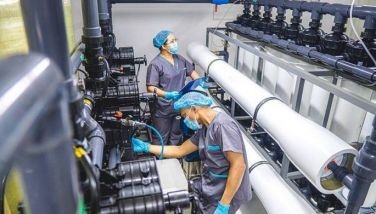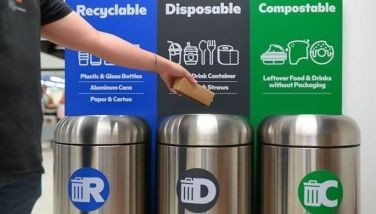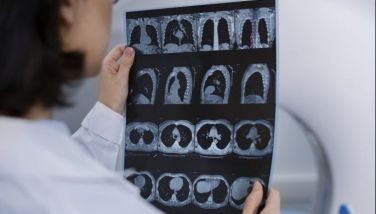Is that a bakeshop or shabu lab?
February 26, 2004 | 12:00am
 Government warning: be mindful of what your neighbors haul into their homes. For all you know, the large mixer you thought was for baking could be used to make shabu.
Government warning: be mindful of what your neighbors haul into their homes. For all you know, the large mixer you thought was for baking could be used to make shabu.
This was the warning made the other night by the anti-illegal drugs task force of the Philippine National Police (PNP) as it made public the names and faces of the country’s most wanted drug traffickers, one of them a woman.
Knowing who are responsible for the country’s drug menace is important, but so is paying attention to what happens in your neighborhood.
Police advise residents to be wary of suspicious-looking machines, obviously unsuitable for homes, which are being hauled next door.
A tip: having large driers in a home doesn’t mean the people living there have a lot of hard-to-dry hair.
The PNP’s Anti-Illegal Drugs Special Operations Task Force (AID-SOTF) have a hotline at 721-2087 as well as to its chief, Police Deputy Director General Edgar Aglipay at 0919-8458888.
Shabu, speed, ice, crystal. Manufacturing this illegal drug, whatever street name it’s known, is a relatively simple process.
All it takes is remembering a little bit of your chemistry and having the right precursors and equipment. Without you knowing it, your nextdoor neighbor could be manufacturing the illegal substance.
In tune with the changing times, drug traffickers nowadays are using more varied and modern equipment to manufacture illegal drugs.
The AID-SOTF identified the stages in the production of the illegal drug and the equipment used by traffickers, then and now.
It starts with the "mixing" process where chemicals or ingredients such as shabu’s main precursor, ephedrine, are used.
Mixing rotor, evaporator and mixer are the standard equipment. Previously, shabu manufacturers used ladle - a long-handled spoon with a deep bowl for serving liquids - a casserole, dipper and mixing rod.
And yes, shabu is cooked.
Sophisticated equipment replaced a gas stove and water purifier in the "cooking" process such as a reactor machine, hot plate, stove, magnetic stirrer, smoke stacks or tubings.
In the "hydrogenation" stage, when the mixed chemicals are combined with hydrogen, gas tanks and rubber tubings or hose are the necessary equipment.
"Filtration" or the mechanical separation of liquid from the undissolved particles floating in it, requires filter paper, vacuum pumps and big funnels.
After filtration, the "freezing" process comes next in order for more crystals to form and thus increase shabu produce.
No longer the typical six-feet average height of refrigerator are used these days for freezing but freezers large enough for people to walk in.
Once the solution has been cooled, large driers replacing electric fans and paper sheets are used to dry the crystalized stuff.
Viola, you have your speed.
According to latest figures from the PNP, more than P13-billion worth of shabu and ephedrine have been seized in the three years that Mrs. Arroyo was president.
A total of 24,405 drug offenders were arrested nationwide while 158 local drug groups have been neutralized.
Cases filed with the courts related to this total 16,761.
Nineteen shabu factories and clandestine laboratories and warehouses were raided and effectively stopped their operations.
The only female on the list of wanted drug traffickers was identified as Xiao Ya Li, a member of the Long Drug Trafficking Group based in Hong Kong.
Two of the most wanted have so far been arrested, namely, William Gan and Mico Tan.
Gan is leader of the Gan Drug Trafficking Group and operator of identified shabu laboratories in Mapulang Lupa, Valenzuela, Santolan and Pasig.
Tan, on the other hand, is operator of "clandestine shabu laboratories" in Carmona, Cavite; BF Homes in Las Piñas and Bayview Towers in Parañaque City.
Also in the list are Qui Yun Hai alias Carlito Go, Jackson Uy alias Dina, Ding Cai Hui alias Tony Lao, Ronald Yao y Cruz, Benito Sze alias Benito Sy, Wen Jin Cai, Chua Lin Yen, Chen Jian Long, Juanito Lee Ty and Henry Tan, who had already been captured but escaped from his detention cell at the Philippine Drug Enforcement Agency (PDEA) in Camp Crame.
BrandSpace Articles
<
>
- Latest
Latest
Latest
February 22, 2025 - 5:26pm
By Rupert Paul Manhit | February 22, 2025 - 5:26pm
February 15, 2025 - 9:00am
By Joyce Ilas-Reyes | February 15, 2025 - 9:00am
February 11, 2025 - 6:32pm
By Nikki Coseteng | February 11, 2025 - 6:32pm
February 10, 2025 - 10:00am
By Nikki Coseteng | February 10, 2025 - 10:00am
February 9, 2025 - 4:11pm
By Nikki Coseteng | February 9, 2025 - 4:11pm
February 9, 2025 - 9:40am
By Jing Castañeda | February 9, 2025 - 9:40am
Recommended

























